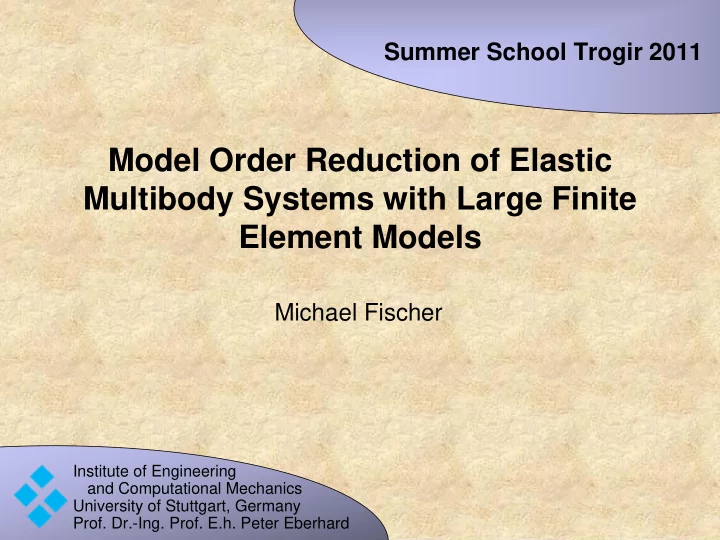

Summer School Trogir 2011 Model Order Reduction of Elastic Multibody Systems with Large Finite Element Models Michael Fischer Institute of Engineering and Computational Mechanics University of Stuttgart, Germany Prof. Dr.-Ing. Prof. E.h. Peter Eberhard
Principle of Elastic Multibody Systems multibody system rigid bodies C elastic multibody system coupling and reduction of constraint elastic degrees elements of freedom elastic bodies discretization improvement of the simulation finite elements, continuum process for flexible multibody finite difference, systems ... Petrov-Galerkin projection to reduce the elastic degrees of freedom Institute of Engineering q V q approximation mit and Computational Mechanics q q University of Stuttgart, Germany ( ) ( ) dim dim Prof. Dr.-Ing. Prof. E.h. Peter Eberhard
Reduction of the Elastic Degrees of Freedom equations of motion of a single body ~ T T m E m c (q) C a h q q 0 ( , ) et a ~ T m c (q) J(q) C (q) α h q q 0 ( , ) er t C C (q) M q h q q K q D q ( , ) et er e e e e forces at cut free nodes are inputs to the MIMO-System displacements of this nodes are outputs to the MIMO-System M q D q K q B u e e e e y C T q e reduction of second order MIMO system (ODE) with sparse system matrices T T T T V M V q V D V q V K V q V B u e e e e T y C V q e Institute of Engineering and Computational Mechanics University of Stuttgart, Germany Prof. Dr.-Ing. Prof. E.h. Peter Eberhard
Programs and different finite element programs Data Flow Ansys Abaqus Permas … standard FEM programs full elastic body user input used for generation of matrices use of alternative Morembs++ / MatMorembs reduction methods different reduction methods (Morembs++ / modal Krylov based SVD/ Gramian MatMorembs) reduction reduction matrix based … advanced MOR can easily reduction be used instead of modal approaches standard MBS programs reduced elastic body used for the simulation of flexible MBS important to keep second order simulation of the elastic multibody system structure Institute of Engineering Simpack Neweul-M² Matlab and Computational Mechanics University of Stuttgart, Germany Prof. Dr.-Ing. Prof. E.h. Peter Eberhard
Numerical Problems in modal reduction Reduction Techniques eigenvalue problem M D K 2 ( ) 0 i e i e e i Component Mode Synthesis constraint modes K K 1 ii ib φ c I bb Krylov subspace moment matching at expansion points K ~ ~ ~ ~ 1 1 1 Γ K D K M K B V V ( , , ) colsp ( ) J b k e e e e e e ( ) k 1 ~ ~ D s M D K s M s D K 2 2 , e k e e e k e k e e modified Gram Schmidt orthogonalization: energy scalar product Institute of Engineering and Computational Mechanics University of Stuttgart, Germany Prof. Dr.-Ing. Prof. E.h. Peter Eberhard
Numerical Problems in SVD / Gramian matrix based Reduction Techniques solution of Lyapunov equations A P P A T B B T 0 A T Q Q A C T C P / Q 0 controllability/ observability Gramian Cholesky factorization Singular Value Decomposition calculation of frequency weighted position Gramian matrix min max 1 1 H H Q i Q i d Q i Q i d P ( ) ( ) ( ) ( ) p 2 2 1 Q i 2 M i D K B max min ( ) ( ) e e e e Proper Orthogonal Decomposition: SVD and eigenvalue problem modern reduction methods approximate the transfer function 1 H s C s 2 M s D K B e e e e e main problem for large systems: inverting large sparse matrices Institute of Engineering and Computational Mechanics University of Stuttgart, Germany Prof. Dr.-Ing. Prof. E.h. Peter Eberhard
inverting large sparse matrices Solving Large = Sparse Systems solving a sparse linear system direct methods (LU factorization) vs. iterative methods usage of central memory fill in is memory-intensive small computational time only one factorization for each right side with large right sides numerical libraries free often not free used numerical libraries for LU factorization UMFPACK GNU GPL Lizenz used in Matlab MUMPS ( MU ltifrontal M assively P arallel sparse direct S olver) in test mode out-of-core solution possible parallel computing with MPI is possible with both libraries Institute of Engineering and Computational Mechanics University of Stuttgart, Germany Prof. Dr.-Ing. Prof. E.h. Peter Eberhard
car body Example of a 2 278 938 dof Large System sparse system matrices 114 million non-zero elements size of system information as a HDF5/Matlab structure: 16 GB approximate usage of memory for one LU factorization: 40 GB Institute of Engineering and Computational Mechanics University of Stuttgart, Germany Prof. Dr.-Ing. Prof. E.h. Peter Eberhard
Results and Outlook results a lot of different numerical algebra in reduction process main problem: LU factorization usage of different numerical libraries to solve large systems efficiently better reduction results for large systems with modern reduction techniques reduction of large models on desktop PCs with out-of-core solver future work better understanding of numerical linear algebra speed up by optimizing numerical linear algebra not only for LU decomposition larger models with up to 10 million degrees of freedom parallelization of numerical operations and data access automated problem depending usage of solution method and numerical library thank you Institute of Engineering and Computational Mechanics for your attention University of Stuttgart, Germany Prof. Dr.-Ing. Prof. E.h. Peter Eberhard
Recommend
More recommend